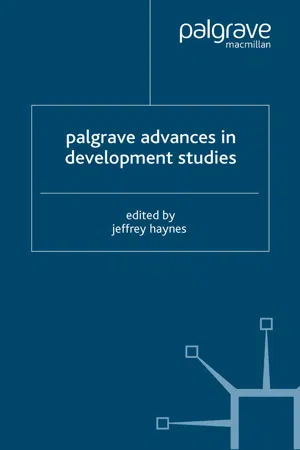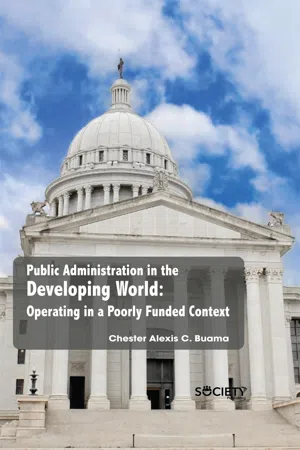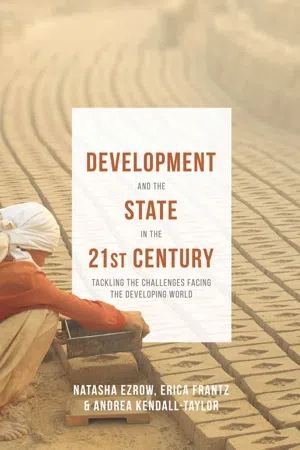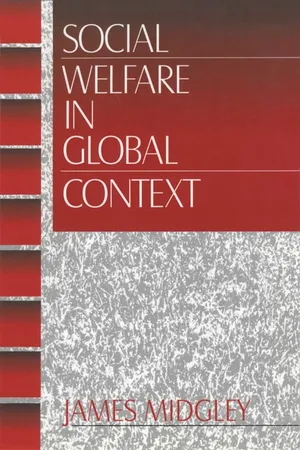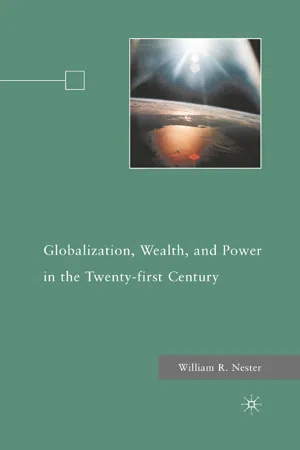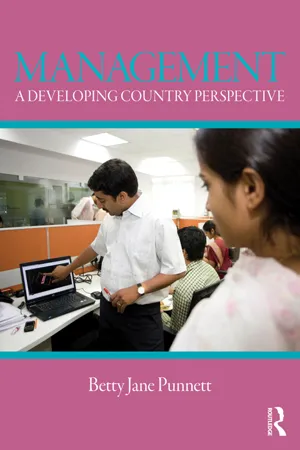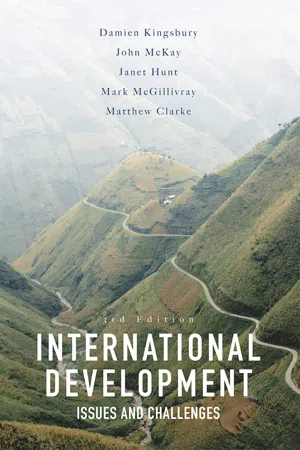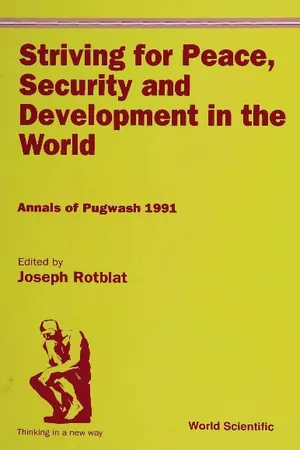Social Sciences
The Developing World
The developing world refers to countries that are still in the process of industrialization and have lower living standards compared to more developed nations. These countries often face challenges such as poverty, lack of access to education and healthcare, and political instability. The term is used to highlight the economic, social, and political disparities between these nations and the more developed ones.
Written by Perlego with AI-assistance
Related key terms
1 of 5
10 Key excerpts on "The Developing World"
- eBook - PDF
- J. Haynes(Author)
- 2005(Publication Date)
- Palgrave Macmillan(Publisher)
For many people, the initially vague and predictive term ‘development’ still struggles to acquire a precise meaning. Initially regarded as both a self-evident and prophetic concept, the widespread assumption in the 1950s and 1960s was that ‘Third World’ (or ‘developing’) countries would – almost inevitably – become ‘developed’ over time. At that 3 4 palgrave advances in development studies time, conventional wisdom had it that over time all countries would necessarily move from a ‘traditional’ to a ‘modern’ state – via economic and technological progress. Following emergence of numerous new countries – especially in Africa and Asia, to join the existing long- independent yet still mostly ‘underdeveloped’ countries in Latin America, what became known as ‘development theory’ emerged to focus on studies of comparative political culture, and the difficult problems of nation- building and how to construct stable and workable institutions and administrations. Now, 40 years on, what comes to mind when we think of the politics, economics and societies of The Developing World (that is, the countries of Africa, Asia, Latin America and the Middle East)? While views no doubt differ widely, it is probably a safe bet to assume that, informed by sometimes unbalanced media coverage, some at least think primarily, or at least to a considerable degree, of negative images. Why? It may be because such information produced by various media sources – especially newspapers, television and radio – can serve to underline political, economic and/or social interactions that often appear to be played out in arenas characterised by political violence and instability, greed and corruption, avarice and malice. In other words, perceptions of what goes on in developing countries may be strongly informed by widely reported examples of political and economic conflict and societal disharmony. - Chester Alexis C. Buama(Author)
- 2020(Publication Date)
- Society Publishing(Publisher)
When compared to developed countries, the developing countries are spread across the globe and are identifiable through their low social and economic factors (refer to Employing Active Learning and the Flipped Classroom Model in Developing Countries: Opportunities and Challenges). There could be developing countries vying to become developed ones in the future with financial resources that are quite rich or other ones that do not have such resources and rather have financial resources that are quite poor (refer to Effects of Quality Education on Sustainability in Developing Countries). Countries with low or medium HDI, low per capita income, low living standards, underdeveloped industry exposed to long spans of recession, an infrastructure that is outdated and low per capita country are acknowledged as developing countries (refer to Problem of Financing Women Entrepreneurs: Experience of Women Entrepreneurs in Post-Conflict Bosnia and Herzegovina). A sovereign state which has lower human development indicators (HDI) as compared to the developed nations, with a low development in the industrial sector is referred to as a developing country. A developing country is also distinguished based on the GDP or per capita income. Public Administration in The Developing World: Operating in a Poorly Funded Context 36 The average annual income is low in a developing country whereby agriculture engages a majority of the population and a major part of the population lives close to the subsistence level. By and large developing countries are dependent on development aid and foreign capital, predominantly agricultural primary resources dependent, are low on industrialization with a weak industrial base (for more refer to Dynamics of Public Expenditure on Defense and Economic Growth Pattern in Developed and Developing Countries). Most of the Asian and African nations are still struggling with the modernization based and related challenges and fall within this category.- eBook - ePub
Development and the State in the 21st Century
Tackling the Challenges facing the Developing World
- Erica Frantz, Natasha M. Ezrow, Andrea Kendall-Taylor, Natasha M. Lindstaedt (née Ezrow)(Authors)
- 2015(Publication Date)
- Bloomsbury Academic(Publisher)
As the case of the DRC underscores, addressing the world’s development needs is no easy task. In this book we seek to shed light on many of the critical issues in the field today and to draw attention to the key challenges that lie ahead. But in order to fully understand why today’s development landscape looks the way it does and to better prepare the field’s future leaders to confront tomorrow’s challenges, we also seek to take stock of where the development community has been in the past. By analysing the evolution of key development theories, and highlighting the many factors that scholars have found to affect development outcomes, we hope to provide a solid foundation on which future practitioners can build.What is The Developing World?The central goal of the field of development is to improve the quality of life for more of the world’s population. Though there is consensus on this point, there is disagreement on most other issues in the field. For one, observers disagree about the set of states that should be the subject of inquiry. Few argue that the United States, Canada, Western Europe, Australia, New Zealand and Japan need development assistance, but from there things get quite contentious. Should states like Qatar, where citizens are often wealthy but lack many basic political rights and liberties, be included in the sample? Should states like Cuba be included, whose citizens, though poor, have better access to a variety of public goods, like education and health care? These are not easy questions and the answers often depend on the specific goals one seeks to achieve.Observers also disagree about the specific terminology that should be used to refer to the sample of states that warrants our attention. During the Cold War, scholars and policy practitioners referred to this group of countries as the ‘Third World’ where countries in the West comprised the First World, the countries associated with the USSR and communism made up the ‘Second World’, and the ‘Third World’ referred to everywhere else. After the end of the Cold War, however, the term ‘Third World’ has become less relevant and has decreased in prominence accordingly. - eBook - PDF
- James Midgley(Author)
- 1997(Publication Date)
- SAGE Publications, Inc(Publisher)
In these countries, debt, conflict, and other factors have impeded progress or even resulted in deteriorating social conditions. There is evidence to show that development trends will continue to diverge in the future. Because of these divergent trends, it makes little sense to describe contemporary social conditions in the Third World as a whole. Instead, the developing countries will be separated into the major continental regions. As may be seen in Tables 3.3, 3.4, and 3.5, key social indicators for these different regional groupings differ significantly. Although it is also possible to classify the developing countries in terms of the level of development described earlier, it is easier to comprehend the current situation on a geographic basis, and there is, in any case, an overlap between the two. As was noted earlier, the countries with the lowest levels of development are to be found largely in Africa. Conditions in Asia The Asian countries have the highest GNP per capita in The Developing World, although there are, of course, significant differences within the region. GNP per capita is highest in the East Asian countries and lowest in the South Asian nations. While the GNP per capita in South Korea is $7,660, it is only $300 in India. Nevertheless, most Asian countries have made significant progress in meeting basic needs. Asia continues to have the highest absolute number of people living in poverty, but the proportion is declining. Although these declines are most marked in East Asian countries such as South Korea and Taiwan, there have been reductions in other parts of Asia as well. The World Bank (1990) estimated that 35% of Asia's population were in poverty. In 1995, Kevin Watkins estimated that this figure had fallen to 30%. The greatest declines took place in East Asia where it is estimated that only 4% of the population will be in poverty by the year 2000. - W. Nester(Author)
- 2010(Publication Date)
- Palgrave Macmillan(Publisher)
146 GLOBALIZATION, WEALTH, AND POWER Clearly there is a dynamic relationship between national development and global politics. A nation’s development is shaped by the policies its gov- ernment pursues in an increasingly interdependent world. Those policies and that development in turn can be helped or hurt by global forces. But internal forces like cultural values, traditions, and institutions, and avail- able human and natural resources are just as crucial to understanding how far a country develops. What Is the Third World? There are many names for the world’s poorer countries: “the Third World,” “the South” (since most of them are in the Southern Hemisphere), “the less developed countries” (LDCs), and “developing countries.” These groups of countries are contrasted with “the First World,” “the North,” “the more developed countries,” “the developed countries,” and “the industrialized countries.” The term “Second World” was used to desig- nate industrialized socialist countries. With the collapse of communism in Eastern Europe and the Soviet Union, “Second World” has fallen into disuse. None of these categories captures the economic diversity among nearly 200 countries. The terms “developed” and “developing” are inadequate. If development is synonymous with progress then most rich and many poor countries are “developing” as measured by achiev- ing higher living standards and quality of life. If measurable progress is truly unending then we cannot say any country is ever truly “devel- oped.” The labels North and South work no better since there are many poor countries in the Northern Hemisphere and some rich countries in the Southern Hemisphere. Although the terms “more” and “less” developed countries capture the relative differences in development, they lack precision in explaining exactly when a country is one or the other.- eBook - PDF
The Discovery of the Third World
Decolonization and the Rise of the New Left in France, c.1950–1976
- Christoph Kalter(Author)
- 2016(Publication Date)
- Cambridge University Press(Publisher)
2.1. A New Paradigm: The Social Sciences 45 tiers monde. The study of that world should not be left solely to the eco- nomic sciences, but should be undertaken in interdisciplinary fashion by economists, sociologists, political scientists, ethnologists, geographers, historians, and demographers. 41 For Balandier, there was no alternative to the development of the Third World. However, in opposition to the optimism about progress and the liberal economic recipes in American scholarship, he warned against a Western “ethnocentrism” in the devel- opment discussion. It was not acceptable to judge all questions “accord- ing to our experience, our past, and our predilections”; “There is not just a single path of access to progress.” 42 On 400 pages, the volume gathered together fifteen essays. One dis- cussed colonialism and decolonization as the conditions that gave rise to the underdeveloped world. 43 Another examined the relations between societies at different levels of development as a macro socio- logical problem. 44 An anthropologist dissected the racism that had previ- ously affected the colonies and was now affecting the underdeveloped countries. 45 A political scientist reported on the discussion of under- development in supranational organizations. 46 An entire section was devoted to the demography of underdevelopment. 47 One author pre- sented a list of indicators for determining underdevelopment. 48 Another criticized this penchant for “criteriology” 49 that was soon common in the literature, because it concealed the fact that underdevelopment was not an “internal” problem of the underdeveloped societies, but a “relational phenomenon” that could not be explained without reference to the development-impeding dominance of the West. 50 Moreover, as necessary as development was, the “social costs of progress” in the Third World had to be registered as a negative. - eBook - PDF
- Adam Szirmai(Author)
- 2015(Publication Date)
- Cambridge University Press(Publisher)
Back-ground material to these statistics is presented in a separate website accompanying this book: http://www.dynamicsofdevelopment.com . 1.3 Growth and development ................................................................................. In the preceding sections, the term ‘ development ’ has fi gured prominently. In common parlance the term is used both frequently and rather casually: development studies, prob-lems of development, developing countries, less developed countries, development cooper-ation, underdevelopment, development aid, development strategies, development policy and so forth. So what do we mean by ‘ development ’ ? Rich countries and poor countries: development as economic growth Implicit in almost every use of the term ‘ development ’ is the notion that some countries and regions of the world are extremely poor, whereas other countries, representing a relatively small fraction of world population, are very prosperous. The discussion of development is always tied up with basic questions like: Why are poor countries poor and rich countries rich? Why do poor countries lag behind rich countries in the development of their standards of living? How can poor countries become more prosperous? How can poor 4 Socio-Economic Development countries catch-up with rich countries? In this sense an important dimension of the concept of ‘ development ’ refers to economic growth – or, more precisely, growth of national income per capita. Development as structural change Development conceived of as economic growth is a quantitative concept and basically means ‘ more of the same ’ . Yet, even if we limit ourselves to the economic sphere, it is clear that economic development is more than economic growth alone. Economic development refers to growth accompanied by qualitative changes in the structure of production and employment, generally referred to as structural change (Kuznets, 1966 ). - eBook - ePub
Management
A Developing Country Perspective
- Betty Jane Punnett(Author)
- 2013(Publication Date)
- Routledge(Publisher)
As defined previously, these are the poorer countries of the world, so they exhibit the effects of being poor. These are also the aspects of developing countries that tend to be in the news, so most people in the developed world do not hear of the positive side of life in developing countries. There is a more positive side to the equation, however. For example: ■ per capita incomes have been growing in developing countries, and there is a growing middle class in many of these countries; ■ some developing countries score quite high on the HDI, indicating that they are good places to live; ■ several developing countries are experiencing high rates of growth; ■ the developing countries represent a very substantial and growing market, and source of supply; ■ concentrations of wealth in developing countries have allowed them to engage in outward international foreign direct investment. Hans Rosling (www.gapminder.org) has argued that we should stop calling a group of countries developing. He presents information on GDP per capita (adjusted for purchasing power parity) and life expectancy to illustrate the changing picture of the wealth and health of nations over the past two hundred years. His statistics show a dramatic convergence among countries in terms of both wealth and health (as seen in life expectancy). While the poorest countries still lag behind in terms of both measures, most countries have moved upward in terms of both quite dramatically in recent decades - eBook - PDF
International Development
Issues and Challenges
- Damien Kingsbury, John McKay, Janet Hunt(Authors)
- 2016(Publication Date)
- Red Globe Press(Publisher)
The second reason was the collapse of the Soviet Union. Many of the countries that emerged from the Soviet Union as independent states were extremely poor and by income standards alone could clearly be labelled as developing. These classifications are still largely used today in official circles despite these changes. While the First World, Second World and Third World terms are not used, those that would have been labelled Third World are officially classi-fied by the United Nations and other official international organizations 42 International Development as ‘developing countries’: 150 countries or territories were classified as developing in 2010. Most of the former Soviet bloc countries in this year were classified as Central and Eastern Europe and Commonwealth Independent States (CIS) countries (UNDP 2010a ). Full lists of the countries belonging to these and all classifications mentioned in the remainder of this chapter can be found in the Human Development Report 2010 (UNDP 2010a ) and on the World Bank website: www. worldbank.org . A number of changes in country classifications have occurred over time. The Czech Republic, Hungary, Poland and Slovakia are all for-mer Soviet bloc countries that are now part of the OECD and as such are generally considered as developed countries. The Republic of Korea (South Korea, as it is more widely known), Mexico and Turkey have in the last decade moved from the developing to the OECD group. Many anomalies remain, however, and for this reason the developing countries group remains highly diverse. Many countries in the develop-ing group should clearly be treated as developed. Singapore and Hong Kong have very high well-being or living-standards levels by interna-tional standards (Hong Kong has been in the top 20 countries in the world in terms of income per capita) and yet are still in the developing countries group in 2014. - eBook - PDF
Striving For Peace, Security And Development In The World: Annals Of Pugwash 1991
Annals of Pugwash 1991
- Joseph Rotblat(Author)
- 1993(Publication Date)
- World Scientific(Publisher)
In 12 of the 23 developing countries in which it is possible to make a comparison of the per capita income of the richest 20 per cent compared with that of the poorest 20 per cent, the income of the richest group was fifteen times that of the poorest group. Although there has been a reduction in the percentage of people living in absolute poverty between 1970 and 1985, there has been an increase in absolute numbers because of population growth. Conclusion Although some encouraging trends, including improved life expectancy, reductions in infant mortality and improvements in literacy, have been seen, there are disturbing declines or failures to progress in a number of regions, particularly in Africa. Considerable resources will be required to reverse these declines, but they are small in comparison to world expenditure on other sectors such as the military. Within developing countries, an increasing recognition of the importance of the informal economy and of the role of non-governmental organizations in development is needed. Economic growth alone is an inadequate indicator of development and the Human 186 Development Indicator devised by the United Nations Development Programme is a first step towards developing a more comprehensive measure of human advancement. References 1. United Nations Development Programme (UNDP). Human Development Report 1990. Oxford University Press, 1990, p 13. 2. United Nations Development Programme, Human Development Report, p 19. 3. United Nations Childrens Fund (UNICEF), The State of the World's Children 1991. Oxford: Oxford University Press, 1991, p 3. 4. United Nations Department of International Economic & Social Affairs, World Population Prospects 1988, Population Studies No 106. United Nations, New York, 1989. 5. R M Anderson, R M May, A T McLean. 'Possible demographic consequences of AIDS in developing countries.
Index pages curate the most relevant extracts from our library of academic textbooks. They’ve been created using an in-house natural language model (NLM), each adding context and meaning to key research topics.
